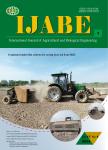Application of nitrogen loaded biochar in purifying agricultural wastewater and as a nitrogen releaser for rice production
作者机构:College of Water ConservancyShenyang Agricultural UniversityShenyang 110866China College of Hydraulic Science and EngineeringYangzhou UniversityYangzhou 225009JiangsuChina
出 版 物:《International Journal of Agricultural and Biological Engineering》 (国际农业与生物工程学报(英文))
年 卷 期:2023年第16卷第4期
页 面:257-262页
核心收录:
基 金:supported by the National Natural Science Foundation of China(Grant No.52009078) China Postdoctoral Science Foundation(Grant No.2021M693863) Liaoning Revitalization Talents Program(Grant No.XLYC1902064)
主 题:biochar ammonia rice eutrophic-water
摘 要:Herein a new approach to the application of agricultural eutrophic wastewater for rice plant cultivation is *** was used as a medium for the sorption of ammonia from simulated wastewater and subsequently as a nitrogen(N)releaser in the cultivation of rice *** main goals of this approach were to isolate ammonia from simulated wastewater and transfer it into rice cultivation,and or explore how exogenous N promoted the growth of *** results demonstrate that according to X-ray diffraction phase analysis,most of the properties of biochar were retained before and after loading NH_(4)^(+)-*** with biochar,the crystal peak of AlOOH in N-loaded biochar(NLB)disappeared and the intensity of the crystal peak of CuCaSe_(2)decreased,which was the important mechanism allowing it to adsorb 30.8%of the N present in simulated low N-concentration agricultural *** soil N content in NLB treatments was higher than in Non-NLB treatments during the critical tillering and reproductive growth ***,the N adsorption-desorption process of NLB matched the N requirements of the rice plant,and thus greatly increased the tiller number by 11.9%and rice yield by 7.5%.These results indicated that the indirect use of ammonia derived from wastewater using biochar as a sorption and releasing medium for rice plant cultivation was *** is the first time that biochar was used for possibly indirect reuse of agricultural eutrophic wastewater and enhancement of rice plant growth.



